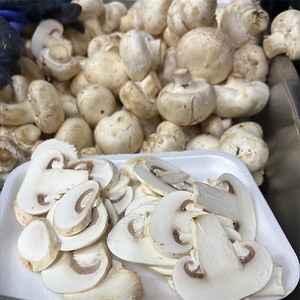


Gewone Mushrooms
Estimated Inventory, lb : 0
Description/Taste
Gewone mushrooms vary in appearance and size, depending on maturity. When young, the caps are smooth, cream-colored to white, and are smaller with a rounder, spherical shape. As the mushroom matures, the cap will flatten and expand, averaging 10 to 20 centimeters in diameter, and the surface will develop yellow undertones, sometimes with a scaly texture. Underneath the cap, the gills are free and crowded, first appearing light pink and then transforming into a dark brown, continuing to darken over time. When the mushroom is young, there is a distinct cogwheel pattern on the unopened veil, and as it matures, the veil runs down the stout stem and forms a small skirt. The stem can grow 4 to 10 centimeters in height and is semi-thin, becoming hollow with age. Gewone mushrooms have thick, white flesh that becomes tender and slightly chewy when cooked and have a sweet, earthy, and nutty flavor. The mushrooms are also known to have a distinct aroma reminiscent of anise or bitter almonds.
Seasons/Availability
Gewone mushrooms are available year-round through select regions of commercial cultivation such as the Netherlands. When found growing in the wild, the mushrooms are available in the early summer through fall.
Current Facts
Gewone mushrooms, botanically classified as Agaricus arvensis, are a common, wild variety that belongs to the Agaricaceae family. Known by many names around the world, including the Anise mushroom in Europe, Field mushroom and Horse mushroom in North America, Almond mushroom in Australia, and Snowball mushroom in New Zealand, Gewone translates from Dutch to mean ordinary or common. Gewone mushrooms are sometimes labeled as Gewone Anijschampignon in local markets throughout the Netherlands, which is a general name for the variety that translates to mean Common Anise mushroom. Gewone mushrooms are primarily found growing alone or in fairy rings, which can sometimes span over many meters in size, and favors nutrient-rich fields, pastures, orchards, or meadows. The mushrooms were once widely foraged across Europe, but due to increased habitat loss, Gewone mushrooms have become more challenging to find growing wild. To meet the demand for the mushrooms in local European markets and to continue the preservation of the species, the mushrooms have also begun to be commercially cultivated in select regions of Europe.
Nutritional Value
Gewone mushrooms are an excellent source of vitamin D, which is a rare vitamin to find in food that can help support healthy bones and nutrient absorption. The mushrooms also contain some potassium, iron, zinc, and copper.
Applications
Gewone mushrooms are best suited for cooked applications such as sautéing, roasting, or grilling. When the mushrooms are young, they can be sliced into omelets, stirred into risotto, tossed into soups and stews, or lightly seasoned and sautéed as a simple side dish. They can also be cooked and served in green salads with flavors that will complement their anise-like fragrance. Mature Gewone mushrooms can be chopped and added to pasta, minced into sauces, layered with eggs on toast, or sautéed and served with roasted meats. The mushroom’s large, mature size can also be used as a substitute for portobello mushrooms in recipes. Gewone mushrooms pair well with lemon juice, sweet cicely, wood sorrel, parmesan cheese, garlic, onions, parsley, meats such as beef or poultry, olives, and capers. The fresh mushrooms will keep 2-3 days when stored whole and unwashed in a paper bag in the refrigerator.
Ethnic/Cultural Info
In Europe, foraging is an ancient but dangerous practice that is still used in the modern-day to provide mushrooms for local markets. When performed sustainably, foragers develop specific maps and routes to reap the benefits of naturally grown food annually. Gewone mushrooms are a favorite variety among European foragers for its neutral flavor and ability to grow to a very large size. Despite their popularity, the mushroom variety has been known to sometimes contain a higher concentration of heavy metals when found growing in the wild and must be consumed in moderation. Foraged Gewone mushrooms must also be carefully examined before consumption as they are similar in appearance to the yellow stainer and destroying angel. When the stem of the yellow stainer is cut, as its name suggests, the exposed flesh turns bright yellow. This is not the case for the Gewone mushroom, whose stem remains primarily white when cut. The destroying angel can be distinguished from the Gewone mushroom by the color of its gills. Gewone mushrooms have brown or pink gills when mature, and the destroying angel has white gills. If foraging, unless there is absolute certainty about a species of mushroom, it is recommended not to eat the mushroom until it has been approved by an expert as one mistaken mushroom can cause lethal consequences.
Geography/History
Gewone mushrooms have been found growing wild in nutrient-rich soils throughout Europe, Asia, and North America and have been present since ancient times. The variety was first described in 1762 by German botanist and mycologist Jacob Christian Schaeffer in Germany, who was one of the first to publish the descriptions of mushroom species never before formally recorded. Once only found in the wild, Gewone mushrooms have been successfully cultivated on a small scale in Europe and are sold through specialty grocers and local markets, especially in Belgium, the Netherlands, England, and Ireland. Gewone mushrooms are also still foraged from the wild and are found in North America, Europe, Asia, Australia, and New Zealand.
Recipe Ideas
Recipes that include Gewone Mushrooms. One








